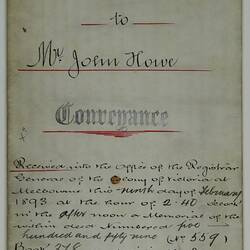Summary
John Howe (circa 1825-1903) was a carpenter who migrated from England to Victoria with his wife in 1854. Settling in Williamstown Howe quickly improved his economic and social circumstances becoming a successful architect, and finally a gentleman. Upon his death he left extensive real estate holdings and other assets to his family both in Australia and in England.
John Howe (also known as John James White Howe, hereafter 'Howe') was born in Devon, England in about 1825. A carpenter by trade, Howe may have been apprenticed to one William Tucker, carpenter, in whose household he lodged in 1851. He married Mary Ann Davis Mather (also known as Mary Ann Marley) at St John's Church, Paddington, London, on March 25, 1854.
A John Howe, carpenter, is listed in an 1856 electoral roll as the owner of a house on Ferguson Street, Williamstown. It is likely that this is the same person, suggesting that Howe and Mary must have migrated to Australia sometime prior, probably as unassisted migrants aboard the Nabob, arriving in Victoria on 20 December 1854.
Howe's economic status prior to arrival in Australia is not well known, but he does not appear to have come from a wealthy family. His marriage certificate lists himself as a carpenter, and his father James a thatcher. Mary's father is listed as a draper. As unassisted immigrants however, Howe must have had the means to pay his and his wife's passage, and the means to own property within two years of arrival.
Howe was a self-made man who worked his way from carpentry, to becoming a successful architect, and finally a gentleman. Howe was involved in the construction of numerous buildings in the Williamstown area in the late 19th century, including the heritage listed 'Tudor House', at 52-54 Pasco Street, Williamstown built in 1884 for WH Roberts, Solicitor (see HT32089 and HT32090).
In April 1886 Howe sold a property on Ferguson Street (possibly his former 1856 residence) to the Welsh Calvinist Church, and was the architect responsible for the design of the heritage listed Welsh Church of the same address, built in 1886.
Howe's son James was employed by Victorian Railways as was Robert Willian and other members of the Willian family. It is possible that the Howes' and the Willians' may have come into contact through work.
On 20 April 1888 at 1.45pm, Robert Willian mortgaged the Princes Street property to John Howe, gentleman, of Melbourne Road, Williamstown for £270, to be paid in monthly £8 instalments. In this complex document John Howe lends a further £44 to Robert Willian, making the total outstanding amount £314.
Howe died a gentleman on 11 January 1903 at his son James' residence, 99 Melbourne Road, North Williamstown, leaving real estate worth £3,323 and personal estate worth £1,450. Howe maintained close ties with his family in England, bequeathing money to Sarah Marley, the widow of his late wife's brother, Henry, as well as to Sarah and Henry's children.
References
Australian Electoral Commission, Australian Electoral Rolls.
Births, Deaths & Marriages Victoria.
Heritage Victoria.
London Metropolitan Archives, Saint John The Evangelist, Paddington, Register of marriages.
Public Record Office of Victoria, Index to Unassisted Passenger Lists to Victoria 1852-1923.
Public Record Office of Victoria, Wills.
The Argus.
The National Archives of the UK, Public Record Office, Census Returns of England and Wales.
The Williamstown Chronicle.
More Information
-
Keywords
Cultures and histories : Melbourne and Victoria, Working Life
-
Authors
-
Article types




